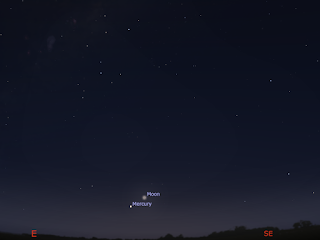Wednesday, February 15, 2023
Thursday February 16 to Thursday February 23
The New Moon is Monday, February 20. Jupiter is sinking towards the horizon into the twilight, coming closer to Venus which is challenging Jupiter for the brightest evening object. On the 22nd the crescent Moon is close to Venus and on the 23rd the Moon is close to Jupiter. The pair and the crescent Moon make a nice sight in the twilight. Bright Mars, the red star Aldebaran and the star Elnath form a line.
The New Moon is Monday, February 20. The Moon is at Perigee, when it is closest to the Earth, on the 19th.
Similar views will be seen from the rest of Australia at the equivalent
local time (60 minutes before sunrise).
Similar views will be seen from the rest of Australia at the equivalent local time (60 minutes after sunset).
Evening sky on Saturday February 18 as seen from Adelaide at 21:31 ACDST, 90 minutes after sunset (click to embiggen). Mars, the red star Aldebaran and the star Elnath form a line.
Similar views will be seen from the rest of Australia at the equivalent local time (90 minutes after sunset).
Between the bright star
Canopus and the Southern Cross are another wealth of binocular objects to
discover.
Elsewhere
in Australia will see a similar view at the equivalent time (90 minutes after sunset).
Mercury is low in the morning twilight and is visited by the Moon on he 19th.
Venus climbs higher in the twilight and is visited by the crescent Moon on the 22nd.
Mars the red star Aldebaran and the star Elnath form a line.
Jupiter is now sinking to the west in the late evening sky. Jupiter is visible most of the evening (setting just after 10 pm) and is the brightest object in the western sky once Venus has set. On the 23rd the Moon is close to Jupiter.
Saturn is lost in the twilight.
Star Map via Virtual sky. Use your mouse to scroll around and press 8 when your pointer is in the map to set to the current time.
Cloud cover predictions can be found at SkippySky.
Here is the near-real time satellite view of the clouds (day and night) http://satview.bom.gov.au/
Labels: weekly sky







 Click to read about or order
Click to read about or order Click to read about or order
Click to read about or order Click to read about or order
Click to read about or order Click to read about or order
Click to read about or order




